► New Honda E long-term test
► What's it like to live with every day?
► Half a year in the Honda electric car
Anyone who says electric cars are boring and threaten to rip the soul out of motoring should have a go in the Honda E. It's certainly not dull to look at – outside or in – and the dramatic design is reinforced by a dynamic repertoire that's beautifully resolved. We love the way the E drives, with a sophistication to the controls, a well judged ride and a joie de vivre that percolates into everything from surprisingly darty handling on a country lane to the extraordinary turning circle.
It feels like a clean-sheet design. Very few cars achieve this – and it perhaps explains why the Honda has more than a passing echo of the bold BMW i3 that came seven years earlier. The premium quality throughout. The modernist cabins and choice of materials. The twang of silent electric thrust, rear-drive handling and the extreme manoeuvrability afforded to the front axle as a consequence of having no driveshafts or combustion engine in the way.
While the Honda can't compete with the Beemer's carbonfibre construction, its connectivity is a leap forwards. The wall-to-wall electro-displays are extraordinary when you first see them, but you quickly adjust and I've been impressed by how natural and undistracting they are. The E sensibly sticks with physical controls for heating, volume and other important regular actions.
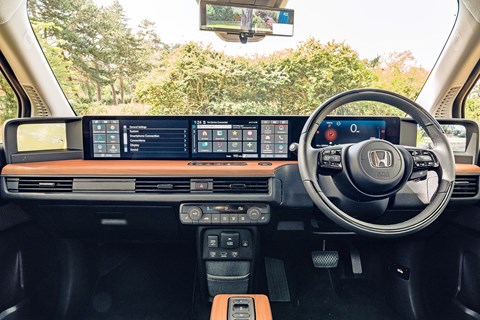
Cameras for door mirrors worked well (by day; electro-black is a little unnerving at night), but I left the internal rear-view mirror in manual mode, preferring the physical reflection to yet another video screen. The only time I relented and flicked to digital was when the boot was packed with recycling – and having a line of sight 'through' the goods was handy. I've had to collapse the rear seats more often than I'd have liked, since the boot is minuscule.
So the Honda E won us over for its dynamics and quality cabin, if not its outright practicality. It's a desirable – though expensive – small car. But is it a good electric vehicle? We've already written extensively about the limited range afforded by its 36kWh battery pack, and you can read the complete Honda E long-term test lower down this page. Suffice to say, town dwellers and those doing regular short hops to the shops are well served by the Honda. Forget the claimed 125-mile range: we never saw more than 100 miles on the meter, even in warmer months.
I charged up overnight on our home 7kW wallbox, which would replenish the small battery in five or so hours. I also discovered you can jump-start an EV, when the Honda's 12v battery died; the dud battery was replaced with no quibbles by Marshall Honda in Peterborough, whose Covid protocols and all-round helpfulness couldn't be faulted.
Overall mileage of less than 4000 miles in half a year reflects the restricted travel patterns of a post-Covid world and we added a modest £163 to our home electricity bill. But it's also a reminder that for longer journeys we typically chose my wife's plug-in hybrid (a VW Passat) over the E owing to that short range. It's a superlative runaround that does its thing beautifully – just make sure that your life can wrap around its abilities.
By Tim Pollard
Logbook: Honda E Advance
Price £29,160 (no options)
Performance 36kWh battery, single e-motor, 152bhp, 8.0sec 0-62mph, 100mph
Efficiency 3.6 miles per kWh (official), 3.1 miles per kWh (tested), 0g/km CO2
Energy cost 4.7p per mile
Miles this month 773
Total miles 3517
Month 5 living with a Honda e: revisiting the greatness of the brand
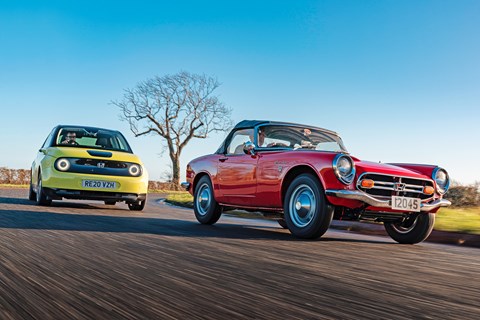
What's the first thing that comes to mind when you think of Honda? High-revving VTEC engines, epic motorbikes and Type R hot hatchbacks? Perhaps Senna and Prost's F1 success and ambitious Asimo robotics? Or the dependable Jazz, unbreakable lawnmowers and power tools that'll work come rain or shine, year after year? Whatever your perception of Honda, I think we can agree that engineering integrity is baked into its DNA – whether your priority is performance, durability or cutting the lawn just so.
Which makes it all the more intriguing to ponder the place of the E in the family tree. To see whether the bijou battery baby deserves membership of the Great Small Honda Club™ we plundered the UK importer's heritage fleet to compare it to a couple of old-timers: one of the brand's very first cars, the petrol-powered S800 roadster from 1967, and the stepping-stone CR-Z hybrid from 2010. Neither was a big seller.
As we gather on a sun-kissed winter's morning, all eyes are drawn to the exquisite S800. Honda only switched from two wheels to four in 1963 and this drophead coupe is an evolution of the brand's first passenger car, the S600. Its design is beguiling, redolent of European sports cars with a long bonnet, pert dimensions and zingy Honda Scarlet paintwork set off by handsome chrome stripes and a power bulge hinting at fireworks to come.
This is a tiny car at just 3.3m long and 1.4m wide, so it's a squeeze to fit in, but it's worth the effort (and removing one's shoes) to do so. This example is factory-fresh, with snug leather seats looking onto a simple dashboard and the stubbiest gearlever I've ever clutched. It's the polar opposite of the E's addiction to digital screens, but has its own sophistication. In many ways, the S800 set the template for the modern kei car – that diminutive footprint matched by the paltry 791cc capacity of the four-cylinder engine. Although tricky to start on a damp morning, it settles to a potent burble and is happy to go for a long drive cross-country.
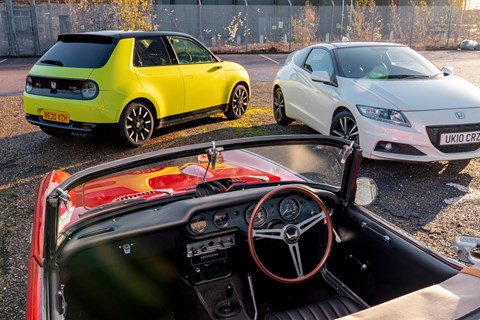
It's a cold morning so we pop the roof back on (a fiddly tonneau cover, but the studs are properly engineered and clip into place perfectly) and head out of town. It's cramped in here and the slender steering wheel fouls my thighs, but there's a deftness and flow to the pocket-sized Honda that bring an instant smile. The gearchange is a delight, with a mechanical precision that encourages you to flick around the four-speeder just for the hell of it, the 0.8-litre engine zipping up and down the rev range, encouraging throttle blips with no electro-nannies attempting to rev-match for you.
The best bit? That 8500rpm redline, like an early blueprint for VTEC. Conscious of the car's age and rarity, I couldn't quite bring myself to rinse it out to the limiter, but I can report that above 7k it shrieks like a mini touring car, a fizzing soundtrack that's even better heard outside than in. You can see how this S800 set the template for the high-revving S2000 that came three decades later.
By the new millennium, Honda design had gone full Japanese and the CR-Z we've brought along to represent the hybrid era couldn't hail from anywhere but Tokyo. The stubby two-door coupe's sawn-off rump echoes the '80s CR-X, the split tailgate window improving rear visibility significantly.
CAR eagerly reported on the launch of the CR-Z in 2010 and Mark Walton picked it when he attempted to return to the UK from Spain after the Icelandic volcano grounded all aviation, using only Honda cars, bikes, mowers and marine engines. A decade on, we're in a different kind of lockdown, but the oddball coupe has aged well. There's a pleasing honesty to the sporty cabin and this era of pre-digital hot hatch has huge appeal. Commands are made with chunky buttons, not soft keys and menus, and this is a rare hybrid with a sweet-flicking manual transmission.

The CR-Z isn't as much fun to drive as the looks suggest, and its 10.2sec 0-62mph time and numb steering blunt thrills, but there's enjoyment to be had balancing the 124bhp combined output with 57mpg eco credentials. 'The CR-Z is exactly the kind of oddball, flawed, contradictory car that Japan occasionally, inadvertently produces,' we concluded at the time and I think we got it right.
What unites all three vehicles is an independent single-mindedness, a determination by Honda to pursue its engineering ideals and stand out from the crowd. The E couldn't be more different from blander European EVs and its charm, character and disruptive interior show that the brand's think-different mentality is alive and well.
The E is the fastest car here, has the sharpest handling, the tightest turning circle and the roomiest cabin; it's living embodiment that we shouldn't mourn the end of the high-revving VTEC era, but rather grasp the opportunities of the electric age ahead. It could be fun, but different – just how Honda likes it.
By Tim Pollard
Logbook: Honda E Advance
Price £29,160
Performance 36kWh battery, single e-motor, 152bhp, 8.0sec 0-62mph, 100mph
Efficiency 3.6 miles per kWh (official), 2.8 miles per kWh (tested), 0g/km CO2
Energy cost 5.8p per mile
Miles this month 752
Total miles 2744
Month 4 of our Honda E long-term test: how far will it go on one charge?
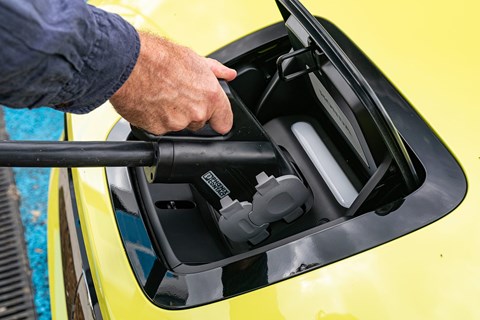
The dreaded R word crops up again and again when conversation turns to our Honda E electric car: range. It’s the elephant in the room; the diminutive 36kWh battery shapes your entire motoring mindset. Quick recap: this is a deliberate move by Honda, which argues that the vast majority of journeys are fewer than 100 miles, so why lug around a big, heavy battery?
In day-to-day duties, this is absolutely fine. Accept that you must adapt your habits to suit – and plug in every single night (much to Mrs P’s chagrin, as we share charging duties with her plug-in Passat wagon). Starting each day with 100 per cent charge is imperative; even the school run becomes quite touch-and-go if you start the day only half full.
Honda quotes 125 miles, but we’ve rarely seen three digits on the range meter. As winter drew in, 80-90 was more common – and that’s a challenge for those of us who don’t live in an urban conurbation. Yes, you can fast-charge on the go, but I believe it’s restricting the appeal of this otherwise brilliant Honda to those living in Britain’s cities.
By Tim Pollard
Logbook: Honda E Advance
Price £29,160
Performance 36kWh battery, single e-motor, 152bhp, 8.0sec 0-62mph, 100mph
Efficiency 3.6 miles per kWh (official), 3.0 miles per kWh (tested), 0g/km CO2
Energy cost 4.8p per mile
Miles this month 667
Total miles 2022
Diary update: flat batteries and jump-starting the Honda E
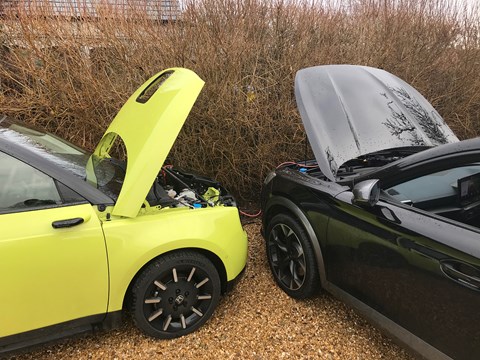
The learning curve on electric cars continues: I never knew you could jump-start an EV, but it turns out you can. What with lockdown and the cold snap, I hadn’t driven the Honda E for a week or so - and one night the alarm went off. I raced outside with the key and noticed the siren was strangled and remarkably quiet and the remote fob was having no effect. Turns out the car’s battery was toast and (thankfully for the neighbours) the racket was soon over as it drained all charge.
Resorting to the manual key that slots in behind the pop-out handle, the car’s electronic brain was dead as a dodo. Cue a look in the manual where advice is given about jump-starting the 12-volt battery (see below). Yes, EVs have regular 12-volt batteries for powering ancillaries and it turns out they too can suffer a flat battery – just not that battery.
The new Cupra Formentor stepped in to lend some charge and the electric Honda sprung to life immediately. We took it for a long drive to charge up the battery and when we got back half an hour later… nothing. Turned out the 12-volt simply wasn’t holding its charge, so we booked in with Peterborough Honda dealer Marshall to investigate.
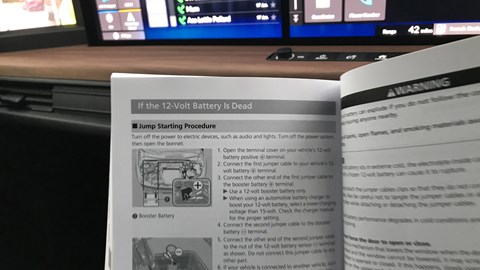
It was my first experience of a car showroom during the Covid-19 pandemic and I was impressed by the slickness of Marshall’s protocols and the friendliness and efficiency of their staff (though less impressed by the Honda Jazz courtesy car being on fumes with just 40 miles of range).
Turns out the E’s 12-volt battery had failed, so it was replaced under warranty and the little Honda returned fit as a fiddle and spotless inside and out. Did it dent my opinion of Honda reliability? Perhaps a little, but on reflection 12V batteries are expendable items and I guess this one might’ve been sat around unused during the E’s long gestation and transit from Japan. I was happy to give it the benefit of the doubt – until I heard from my colleague, video boss James Dennison, that a different E suffered a similar fate when he shot a film in 2020. Hmmm…
By Tim Pollard
Month 3 of our Honda E long-term test: comparing notes with a Jaguar i-Pace driver

Editor-in-chief Phil McNamara really fell for the Jaguar i-Pace he ran for several months, but he hadn’t driven my Honda E. So we spent a couple of hours piloting the two around the Midlands in a back-to-back comparison.
Wildly different segments (crossover versus city car) and prices (£65k plays £29k), but this duo share more than you might expect, including sophisticated chassis poise and uncanny acceleration, though the Honda doesn’t come close to the Jag’s mighty 4.8sec 0-62mph thrust.
Phil hailed the E ‘a Tokyo concept car made real’. He’s right (as usual). What unites this pair is the fresh approach to design – they’re both unencumbered by what went before, and all the better for it.
By Tim Pollard
Logbook: Honda E Advance
Price £29,160
Performance 36kWh battery, single e-motor, 152bhp, 8.0sec 0-62mph, 100mph
Efficiency 3.6 miles per kWh (official), 3.1 miles per kWh (tested), 0g/km CO2
Energy cost 4.2p per mile
Miles this month 484
Total miles 1355
Month 2 living with a Honda E: that digital screen
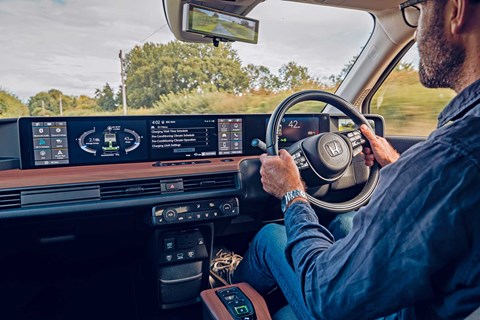
When people find out I’m driving a Honda E, the main thing most of them want to ask about (and there are plenty of questions) is the panoramic digital screen. The outside of the E is cartoonishly striking but it’s in here where the special stuff happens. How many small cars have wall-to-wall electronic read-outs, a virtual aquarium that bobs fish across your dashboard and video cameras for mirrors?
I may work in digital media, but I love analogue where physical form is better – a magazine crafted with love and care, for instance, and a face-to-face meeting rather than another bloody video conference call. But there’s a time and a place for digital features and after just one month I’m convinced Honda is onto a winner with this interior.
It’s not actually one giant screen; like other ultra-widescreens, it’s actually several displays stitched together. An eight-inch read-out in the instrument binnacle clusters dials for speed and driving modes, and that’s joined by a pair of 11-inch displays to the left, stretching across most of the dash.
These two touchscreens manage to hide grubby fingerprints most effectively. Hats off also to the simple, clear typeface and general user interface, which makes menus easy to swipe through and selections intuitive to make. Honda’s clearly observed what works on mobile devices and what doesn’t. Those three digital displays are bookended by a pair of five-inch camera screens in lieu of door mirrors. They’re quick-acting and work well, although it’s still a bit strange if you try to peer around a corner by craning your neck only to see an unchanged video angle.
It might have big screens but the E has a small range, as evidenced by the 43 miles in the photo above with the battery half full. We’re currently averaging 3.1 miles on every kilowatt-hour of energy, and with the average domestic electricity cost of 14.3p per kWh, that means we’ve theoretically spent less than £30 to drive more than 600 miles this month.
By Tim Pollard
Logbook: Honda E Advance
Price £29,160
Performance 36kWh battery, single e-motor, 152bhp, 8.0sec 0-62mph, 100mph
Efficiency 3.6 miles per kWh (official), 3.1 miles per kWh (tested), 0g/km CO2
Energy cost 4.6p per mile
Miles this month 630
Total miles 871
Diary update: pop-out door handles struggle in the frost
Winter's finally arrived in the UK, icy frosts wrapping the ground with a crisp, crunchy cape some mornings. And it's brought an unusual problem: the Honda E's pop-out door handles were frozen on one particularly cold morning this week. As you'll see in the tweet above - they wouldn't budge an inch!
There were kids to take to school, huffing and puffing impatiently. There was me, wondering whether I could get in via the back doors and scramble into the front seats. And my guilt for having not pre-conditioned the E overnight on this occasion.
After a minute of prodding and trying, the frost thawed, the handle released and I was in. No special measures required. Still, I was left nonplussed. It wasn't even that cold: a night hovering around, and perhaps just under, zero. A heavy frost, granted, but I was suprised that the Honda's door handles were stuck solid.
I'll be using the pre-heating more often in the weeks ahead, and keep an eye on what happens when the temperatures really plummet.
By Tim Pollard
Month 1 of our Honda E long-term test: introducing the baby battery car to the CAR magazine fleet
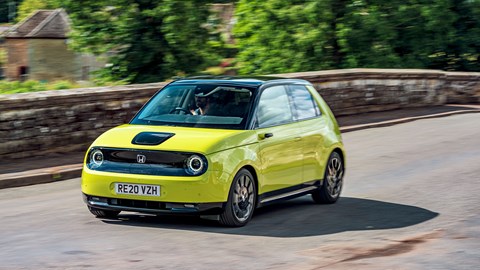
It’s good to be back in an electric car. Research has proved that deciding to own an EV is pretty much a one-way gate; few take the plunge and then go back to internal combustion. Yet my automotive CV has yo-yo’d wildly back and forth in recent years – from a BMW i3 to a Tesla Model S, via an Audi A8 (diesel, yuk!), Lexus RX450h (hybrid halfway house) and on-the-spectrum Bentley Continental GT (V8, petrol, sledgehammer fast).
It’s one of the perks of this job that we move between brands, segments and motive powers. And I’m glad to be in a battery car for the next six months.
Why? Because EVs are inherently interesting to live with and write about. Electrification is an irresistible tsunami transforming the car industry, and the benefits are manifold and tangible. I’m hoping I’ll again enjoy the silence and peace of driving an EV every day. The feeling that I’m not pumping noxious pollutants into the local environment from a tailpipe. The addictive thrust so readily on tap from a 152bhp motor driving the rear wheels. And waking up every morning with a ‘full tank’.
Electric cars: further reading
Our guide to the best EVs on sale
How much does it cost to charge and EV?
The most affordable electric cars
So I’m feeling optimistic about life with the Honda E. I have good reason; I penned the Giant Test for CAR magazine, where it took on and damn nearly toppled the Peugeot e-208 and Mini Electric. This is a very special car, one of those once-in-a-generation cars for the marque – ‘the most significant Honda since the 1989 NSX’, I mused. Only its short range and cramped boot held it back from sweeping to victory. Whoops, I’ve blurted it out early: the E does have some compromises, but this test will allow me to judge them afresh.
Ours is a top-spec Advance model, likely to be picked by most buyers. And just look at it! It’s unlike anything else on the roads and is already garnering interest left, right and centre. I imagine the stillborn Apple car project might’ve looked like this – that crisp, minimalist vibe that Silicon Valley would kill for, but backed up with the reassuring Honda badge.
The early omens are good. The exquisite engineering integrity that so impressed on the group test reminds me of the i3 I lived with back in 2016: the compact footprint, rear-wheel-drive handling and steering feel, extraordinary turning circle and bold purity of concept. The baby Beemer was all the more impressive for arriving seven years ago and Honda’s blazing fewer trails as a result.
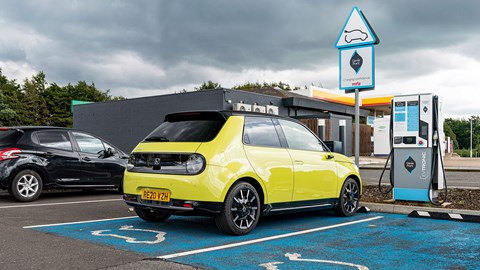
Get past the cartoonish exterior, slide into the cabin and prepare to be amazed. The first thing that grabs your attention is the wall-to-wall digital interior, huge touchscreens stretching from A-pillar to A-pillar, bookended by electronic door mirrors like on the Audi e-Tron.
Will it stand the test of time? I can’t wait to see if the virtual instrumentation works, or whether it’ll be used as much as those dozens of apps you download when you get your first smartphone and never use.
But you then notice the wool-upholstered seats, the well-judged wooden trim, the carpet-trimmed door caps and the wonderful sense of space cultivated by the flat floor and lack of centre console. You prod and stroke and tap and realise it’s all beautifully built – and the materials are a step up from the usual Honda stuff.
It’s safe to say I’m really looking forward to spending time in the E. The raw maths of its tiddly 36kWh lithium-ion battery mean I’m expecting to be hamstrung by the limiting (claimed) 125-mile range, but I’m trying to adjust my mindset to accept that. It’s aimed at day-to-day chores and shorter inter-city hops, not long drives to the airport or far-flung family holidays. It has points in the bank for its utterly captivating charms, but real life is about to test the Honda E’s mettle harder than any streetside cooing ever will. Stay tuned.
By Tim Pollard
Logbook: Honda E specs and running costs
Price £29,160
Performance 36kWh battery, single e-motor, 152bhp, 8.0sec 0-62mph, 100mph
Efficiency 3.6 miles per kWh (official), 3.2 miles per kWh (tested), 0g/km CO2
Energy cost 3.6p per mile
Miles this month 37
Total miles 241
Spec secrets: how we specced our Honda E Advance
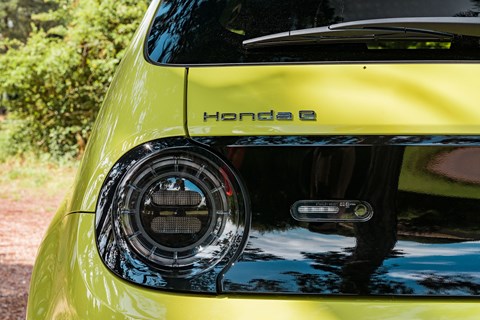
Which one are we running?
Picking a Honda E is simple: there are only two trims available – the regular model retailing at £26,660 and this top-line Advance model for £29,160. Both prices are after the £3000 discount afforded by the government’s Plug In Car Grant. That’s a tenth off!
Advance: fully loaded!
Our Advance is well equipped as standard and comes with precisely no options at all. What you see on the spec list is what you get: radar cruise and lane keep, sat-nav, digital everything, keyless entry and ignition. It’s absolutely loaded for a small car.
No spare wheel
Those 17-inch alloys are decidedly cool: a dual-tone mix of painted black and polished brightwork which look simultaneously retro-kitsch and modernist. There’s no spare wheel, just a can of gunk under the flap of the boot floor. I hope we never have to use it...
Pay-as-you-go: Honda E finance deals
If you think nearly 30 big ones for a city car is absurd, may we present to you the tempting PCP packages doing the rounds. At time of writing, Honda will flog you a base E for £249 a month after £5704 down over three years at 5.9% APR interest. Nifty.
Charge!
Searing paintjob is Charge Yellow. It’s a no-cost option on the E and contrasts splendidly with the black roof, charging flap, light facias front and rear, and alloy wheels.
More long-term tests by CAR magazine